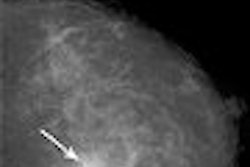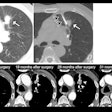A first-time categorical course at the 2006 Society for Interventional Radiology (SIR) meeting in Toronto will focus on breast interventions.
Held on Saturday, April 1, the one-and-a-half hour session will feature the following speakers and topics:
- Stereotactic breast biopsy by Dr. Derek Muradali from St. Michael's Hospital, University of Toronto
- Breast needle localization by Dr. Supriya Kulkarni from Princess Margaret Hospital, University of Toronto
- Ultrasound interventions by Dr. Elsie Levin from Faulkner-Sagoff Breast Imaging and Diagnostic Centre, Boston
- MRI interventions by Dr. Lia Bartella from Memorial Sloan-Kettering Cancer Center, New York City
- Characteristics of breast abnormalities; practice development by Dr. Kenneth Tomkovich from CentraState Medical Center, Freehold, NJ
Tomkovich, who is the director of vascular and interventional radiology at the Freehold center, coordinated the course and will serve as the moderator. In an interview with AuntMinnie.com, Tomkovich -- along with Dr. John Kaufman, chairman of the SIR scientific committee -- offered their thoughts on why this course is particularly relevant in 2006.
AuntMinnie.com: Why did SIR decide that this is the right time for a breast interventions course?
Kaufman: SIR conducts annual surveys of its members to assess continuing education needs. This topic came to light through this survey, and from direct input from SIR members.
In many radiology practices, the interventional radiologists in the group perform the majority of biopsies in addition to other interventions. At the same time, a large percentage of our membership spends part of their time in diagnostic radiology, including mammography.
Lastly, there is a growing emphasis in IR practices on focusing on patient groups, rather than individual procedures. Women's health is just one of these emerging focuses, and breast biopsy is just one of many image-guided procedures that we can offer our female patients. Based on these considerations, introducing a course on breast interventions seemed to make a lot of sense.
Breast intervention is a term that covers a wide array of procedures. How did you ultimately decide on the six that will be presented?
Tomkovich: The course is designed to give an overview of breast interventions. I think those physicians who are doing breast procedures will benefit from the experienced faculty providing their expertise on needle localization, stereotactic-guided, ultrasound-guided, and MRI-guided interventions, including a brief discussion of breast ablation.
For those who are not currently doing breast interventions, this will be a good introduction into the many procedures that can be performed by interventional radiologists in both the office and hospital practices. The topic of practice development should benefit all who attend.
Do you think that there is any intraspecialty turf war between IR and mammographers over who should perform breast biopsy?
Kaufman: Interventional radiologists are not looking at this as a "turf" issue, but as an opportunity to contribute to the overall health of women. The role of IR in breast imaging and interventions will be different in each practice depending on the composition of the group and the interests of the interventional radiologists and the mammographers. A team approach will likely exist in most settings.
In terms of the potential turf war between breast surgeons and IR over biopsy, what advantages do you think IR has over surgeons? What are some proactive measures that interventional radiologists can take to make sure that they aren't losing ground to surgeons in this area?
Kaufman: Image-guided breast biopsy is already largely a radiology procedure at this time. As with any procedure, the key to maintaining a meaningful role is to participate in the before and after evaluation and care -- not just the procedure itself. By taking an interest in the diagnosis and longitudinal management of breast diseases, IRs can provide high-quality care for these patients.
Tomkovich: I do not see this as a turf issue. A large percentage of my referrals are from breast surgeons. I am able to see their patients, analyze the imaging, and do the appropriate image-guided biopsy procedure to give the surgeon an accurate diagnosis. The surgeons will then be seeing a patient who has had a complete workup so that they can appropriately plan and discuss surgical options with their patients.
By Shalmali Pal
AuntMinnie.com staff writer
March 21, 2006
Related Reading
New report slams breast imaging as flawed compared to biopsy, February 9, 2006
Radiologists maintain dominance in breast biopsy procedures, January 10, 2006
Panel favors greater use of less invasive methods for diagnosing breast cancer, October 7, 2005
Copyright © 2006 AuntMinnie.com



















